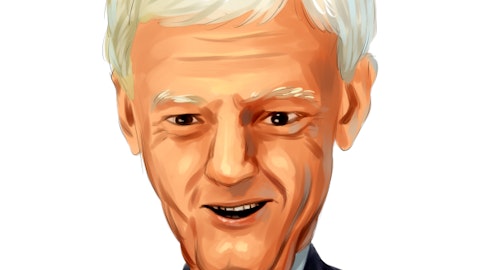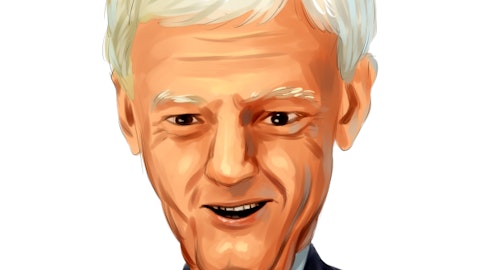Adam Josephson: Got it. Thanks Larry. And on the GIP business, can you — are you at liberty to talk about what your volume assumptions are? What your steel price assumptions are? And relative to the $100 million onetime price/cost benefit you had in steel in fiscal ’21, what — I assume you’re assuming a pretty significant onetime hit, particularly in 1H ’23. Any details you could give us just along all those lines and the GIP business would be helpful. Thank you very much.
Larry Hilsheimer: Yes. Yes. So on — so let me give you a broad — for the U.S. business, the CRU index for 2022 averaged 1,806. Okay? Started out the year at 22.93, ended up the year at 12.54. For ’23, against that 1,806, we’re showing an average for the year of 1,056. So a pretty dramatic increase in the index side of that. For Europe, which is by far and away the largest, it’s 4x the size of U.S. in terms of volumes. But we show a — in ’22, it was 1,155. So $1,155 a ton. And in Europe, it’s 814 is the average for our ’23 assumptions. And from a volume basis, we are forecasting for the year, the volumes down — on a global basis, Adam, about just shy of 3%, just shy of 1% in plastics, fiber down 3%. IBC is even down 1.5% sort of at the middle of our ranges that we did in those spaces.
Now to give you a further breakdown, North America were up — just shy of 6%. So dramatic decrease in North America, and EMEA about 3%. If I go volume-wise, now this is a mix of things we’ve got kind of different assumptions across shutdowns and all that kind of thing, but I won’t talk about mills because there’s all kinds of different things on downtimes planned for maintenance and that kind of thing. But in our sheet business, we’re expecting about 3%, same thing on tube and core, down 3%.
Adam Josephson: And just on the onetime hit that you’re expecting from falling steel relative to the $100 million onetime benefit you had in fiscal ’21?
Larry Hilsheimer: Yes. We haven’t calculated that number, Adam. So I don’t have it for you.
Adam Josephson: Okay. Thanks so much Larry.
Operator: Thank you. One moment. Our next question comes from George Staphos with Bank of America. Your line is now open.
George Staphos: Thanks a lot. Larry, Matt, Ole, good morning, and congratulations on the progress in ’22. I guess my first question would be within your guidance, and thank you for going through the detail that you could provide. Larry, I thought I heard you say that you do have something for Lee Container built in. If I heard that correctly, can you help us out a bit in terms of what we should be baking in both in terms of EBITDA? And how much it contributed to the interest expense uplift? And then I had a follow-on.
Larry Hilsheimer: Yes. Thanks, George. So I’d put somewhere between 25 and 30. It’s going to just depend on some of the — we haven’t worked through all of the impacts, what valuation adjustments might have on inventory opening day and those kind of things. So I’d say 25 to 30 would be a good range to put in on Lee for this year, and then we expect that to expand nicely beyond that in the future years. On the interest expense, you look back, we ended up paying down about roughly $300 million of debt in 2022. We’ll be taking on about $300 million in 2023. We’ve generally had a policy of fixing 40% to 60% of our debt. And we moved that up beginning in March, April this year when we did some refinancing. I asked our team to start to trend up to the top end of that 60%.
And then as we rolled out our strategy and knew we would be going in the acquisition space, I asked our treasury team to move it up even further, to get ahead of our plans and roll it up to where we are approaching in the 80, where we’re at now after we do the Lee acquisition will be about 65% fixed. And we believe that helps us manage our capital structure in a flexible manner and gives us more repayment opportunities if we don’t find other acquisitions. So the bottom line of it is, if you look at it, last year, our interest expense was about $61 million, so 3% of $2 billion of debt. If you say we’re going to be at about that same level of debt, I don’t fluctuate through the year. But if you have 35% of that is floating with interest rates, you say, 35% of that $61 million.
Floating rates have about tripled. So you’ve got another $60 million, $65 million of interest expense that will be related to that and puts us at an overall of $100 million to $105 million.
George Staphos: Larry, that’s great. We appreciate all that color. Very, very helpful. I guess my other question and just on exit rates on volume, you mentioned that volumes were declining sequentially across GIP. Could you talk to us — and certainly, they were down also in PPS. Can you tell us where early in the new year, volumes are trending? And it would be helpful, obviously, because we have at least your volume forecast for the year, relative to the other Q&A. Thanks. I’ll turn it over.
Ole Rosgaard: I’ll take that one. So obviously, we saw demand enrolling sequentially throughout the quarter. That softness has continued into November, but is stabilizing as we see it. We also believe there is some destocking going on, both in Q3 and into Q4, but primarily on the paper side.





